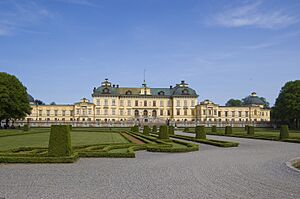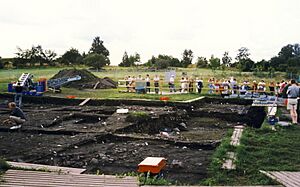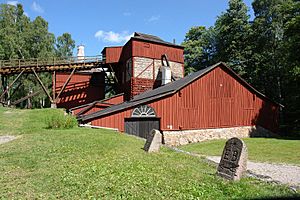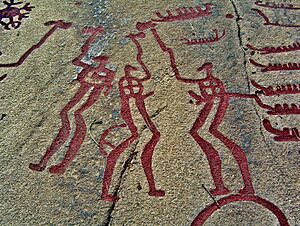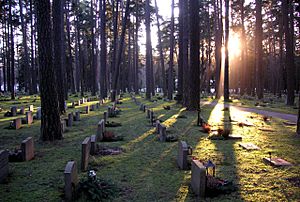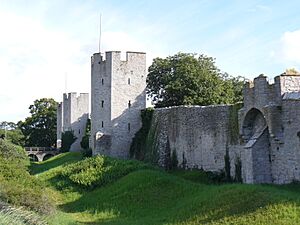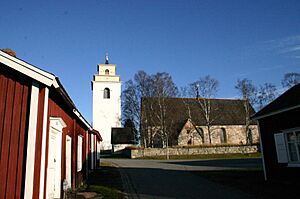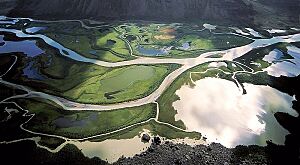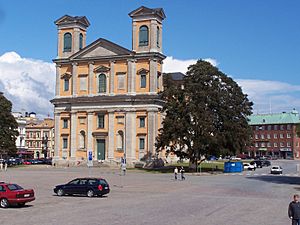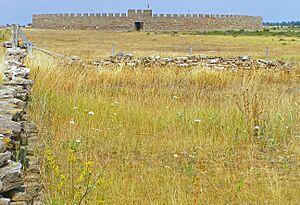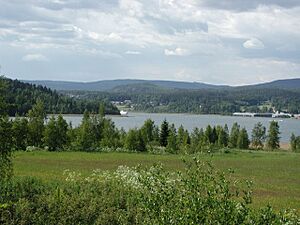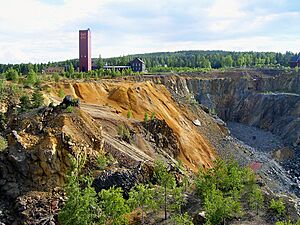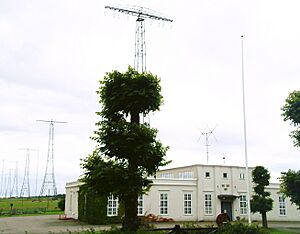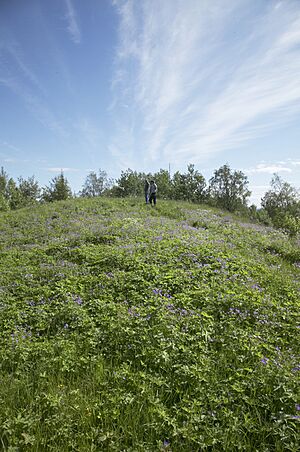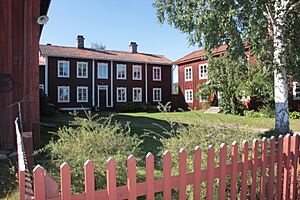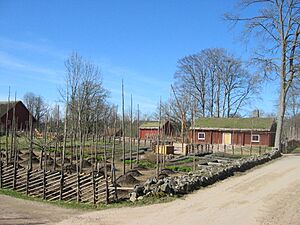List of World Heritage Sites in Sweden facts for kids
Have you ever heard of UNESCO? It stands for the United Nations Educational, Scientific and Cultural Organization. UNESCO helps protect special places around the world. These places are called World Heritage Sites. They are important for our history, culture, or nature.
A place can be a cultural site if it's a monument, a group of buildings, or an archaeological site. It could be an old palace or an ancient city. A natural site is important for its physical features, plants, or animals. It could be a unique landscape or a home for rare species.
Sweden agreed to protect these sites in 1985. This meant its historical and natural places could become World Heritage Sites. As of 2020, Sweden has 15 such sites. Most are cultural, but there's one natural site and one mixed site.
The first Swedish site added was the Royal Domain of Drottningholm in 1991. The newest one is the Decorated Farmhouses of Hälsingland, added in 2012. Some sites are shared with other countries. For example, the High Coast is shared with Finland. The Struve Geodetic Arc is shared with nine other countries!
Contents
- Sweden's Amazing World Heritage Sites
- Royal Domain of Drottningholm
- Birka and Hovgården: Viking Age Centers
- Engelsberg Ironworks: A Look at Old Industry
- Rock Carvings in Tanum: Ancient Art
- Skogskyrkogården: The Woodland Cemetery
- Hanseatic Town of Visby: A Medieval Trading Hub
- Church Town of Gammelstad, Luleå
- Laponian Area: Home of the Saami People
- Naval Port of Karlskrona: A Baroque City
- Agricultural Landscape of Southern Öland
- High Coast / Kvarken Archipelago: Rising Land
- Mining Area of the Great Copper Mountain in Falun
- Grimeton Radio Station, Varberg
- Struve Geodetic Arc: Measuring the Earth
- Decorated Farmhouses of Hälsingland
- Tentative Sites: Future World Heritage
- See also
Sweden's Amazing World Heritage Sites
UNESCO chooses sites based on ten different rules. Each site must meet at least one rule. Rules one to six are for cultural sites. Rules seven to ten are for natural sites.
Royal Domain of Drottningholm
The Drottningholm Palace is where the Swedish royal family lives. It's on an island near Stockholm. This palace was built in the 1600s and changed in the 1700s.
It has a working theatre and a Chinese Pavilion. The palace shows how powerful Sweden was in the 17th century. Its design was inspired by the famous Palace of Versailles in France.
Birka and Hovgården: Viking Age Centers
These two sites show us what life was like in the Viking Age. Birka was a very important trading town in the Baltic Sea. It was busiest between 750 and 980 CE.
Birka was also home to Sweden's first Christian church, started around 830. Later, Sigtuna became the main trading center. The royal family stayed at nearby Hovgården. You can still see ruins of Alsnö hus there.
Engelsberg Ironworks: A Look at Old Industry
Engelsberg Ironworks is a great example of an old Swedish iron factory. It shows how iron was made from the 1600s to the 1800s. Sweden was a world leader in iron production back then.
People have been mining iron here since the 1100s. The first large furnace was built in 1681. The factory closed in 1919 because it was no longer profitable. More than 50 buildings are still preserved today.
Rock Carvings in Tanum: Ancient Art
These amazing petroglyphs are carved into granite rocks. They were made during the Nordic Bronze Age, from about 1700 to 500 BCE. There are about 1500 known carving sites.
The carvings show humans, animals, weapons, and tools. They teach us about the lives and beliefs of the people who made them. Some carvings have been painted red to help visitors see them better.
Skogskyrkogården: The Woodland Cemetery
Skogskyrkogården, also known as "The Woodland Cemetery," is in southern Stockholm. It was designed by architects Gunnar Asplund and Sigurd Lewerentz. It was built between 1917 and 1940.
This cemetery is special because its buildings blend perfectly with nature. It has inspired cemetery designs all over the world.
Hanseatic Town of Visby: A Medieval Trading Hub
The town of Visby is on the island of Gotland. It was a major center for the Hanseatic League from the 1100s to the 1300s. The Hanseatic League was a powerful group of trading cities.
Visby started as a Viking settlement. In the 1200s, it grew into a big city with strong defensive walls. Over 200 old warehouses and merchant homes from medieval times are still standing.
Church Town of Gammelstad, Luleå
Gammelstad is the oldest and best-preserved "church village" in northern Scandinavia. It has a 15th-century stone church, Nederluleå Church. Around the church are over 400 wooden cottages.
These cottages were built for people who traveled long distances to attend church. Because the area was spread out and travel was hard, the cottages gave worshippers a place to stay overnight.
Laponian Area: Home of the Saami People
The Laponian area is a huge mountain wilderness in northern Sweden. It covers about 9,400 square kilometers. It's the world's largest natural area still used by its native people.
The Saami people live here and herd reindeer, following their traditional migration paths. This area has four national parks and two nature reserves. It's also important for its unique landforms and many different kinds of plants and animals.
Karlskrona is Sweden's only city built in the Baroque style. It was founded in 1680 by King Charles XI. It was meant to be the new naval base for the Swedish Navy.
The site includes the city, naval buildings, and old forts. Karlskrona's design was inspired by older naval bases. In turn, it influenced how other naval cities were built.
Agricultural Landscape of Southern Öland
The southern part of Öland island has a large limestone plateau called Stora Alvaret. People have lived on this island for about 5,000 years. The soil here is not very rich.
For thousands of years, people have used different areas for grazing animals and for farming. This shows how they adapted to the land.
High Coast / Kvarken Archipelago: Rising Land
The High Coast in Sweden and the Kvarken Archipelago in Finland are both in the Gulf of Bothnia. They have thousands of islands. This area shows amazing effects of land rising.
After the last Ice Age, huge glaciers melted. This removed a lot of weight from the land. The land has been rising ever since, changing the landscape constantly. In some places, it has risen almost 300 meters!
Mining Area of the Great Copper Mountain in Falun
The Great Copper Mountain was one of Europe's most important mining areas. It produced a lot of copper. Mining started here in the 800s and was biggest in the 1600s.
The most famous part is the huge open pit called Stora Stöten. Besides the mine, there are many small mining villages. They show us how mining communities grew and changed over time.
Grimeton Radio Station, Varberg
Grimeton Radio Station is an old longwave radio station. It was built between 1922 and 1924 to send messages across the Atlantic Ocean. The main buildings were designed in a classic style.
Its antenna towers are 127 meters tall! They were the tallest structures in Sweden when they were built. This station still works today, using old radio technology.
Struve Geodetic Arc: Measuring the Earth
The Struve Geodetic Arc is a chain of survey points. It stretches over 2,820 kilometers from Norway to the Black Sea. These points were set up by astronomer Friedrich Georg Wilhelm von Struve.
He used them to accurately measure a long part of the Earth. This helped us understand the Earth's size and shape. The World Heritage Site includes 34 points in ten countries. Four of these points are in Sweden.
Decorated Farmhouses of Hälsingland
This site includes seven timber farmhouses in Gävleborg County. Wealthy farmers built them in the 1800s. They hired local artists to paint the insides.
Special rooms for parties were the most decorated. The paintings mix folk art with styles like Baroque and Rococo. These farmhouses show the rich culture of the area.
Tentative Sites: Future World Heritage
Besides the sites already on the list, countries can suggest new ones. These are called "tentative sites." A site must be on this list before it can become a World Heritage Site. As of 2020, Sweden has one site on its tentative list.
The Rise of Systematic Biology
This site is about the start of modern biology. It includes places connected to Carl Linnaeus. He was a famous scientist who created the system for naming plants and animals.
The Swedish parts of this site include Råshult (where he was born), the Linnaean Garden, and other natural areas.
See also
 In Spanish: Anexo:Patrimonio de la Humanidad en Suecia para niños
In Spanish: Anexo:Patrimonio de la Humanidad en Suecia para niños
- Tourism in Sweden
- List of national parks of Sweden


